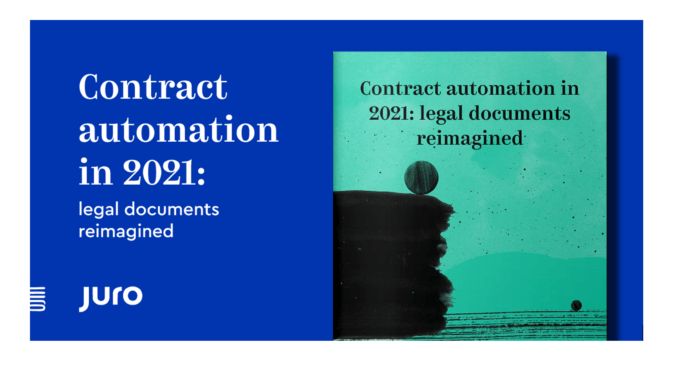
Introducing a new downloadable whitepaper by Juro.
Automation isn’t new to legal, by any means. While we lawyers were slow to embrace automation, often still living in the same word processors we’ve used for 30 years, legal teams have at least begun to address routine documents with templated processes.
[Download the whitepaper – ‘Contract automation in 2021: legal documents reimagined.’]
But with so much noise and hype around contract automation, we can lose sight of quite how far contract automation has come since the early pioneers first pushed Word documents into mail merge software.
Navigating the myths and misconceptions is tough enough, but implementing an automation project can be an even bigger challenge – especially for small legal teams in fast-growing companies, where life is a constant balancing act and time is your most precious asset.
2020 was radically different from 2019, for all of us. Enforced remote working exposed many of the fault lines in legal, particularly when it comes to the adoption of legal technology, not just in legal teams but throughout the business.
With other teams happily collaborating through in-browser platforms, like Slack and Notion, rather than shared drives, it’s time to take stock of which contract automation practices we want to build on – and which are already past their sell-by-date. 2021 needs to be different too.
Signs that contract automation is helpful, but not transformative, are everywhere. Legal teams that consider themselves to be innovative are still wasting time renaming documents to be ‘MSA_v18’, ‘MSA_v19’, ‘MSA_final’, and of course ‘MSA_FinalFinal_DontDelete.’
Legal teams are still fighting for IT support on implementation, struggling to impose new ways of working on commercial colleagues, and somehow ending up still hunting through email chains for Word documents.
Contract automation often fails due to a lack of adoption in the wider business. Frequently that’s down to software that’s poorly designed and too hard to use, but issues with data also hamper legal teams looking to fit into their colleagues’ systems of record. Contract automation tools don’t always capture data, or if they do, they fail to feed it seamlessly into the systems of record relied on by their colleagues.
‘No-code’ is starting to reach buzzword status, but behind it is the very real pain point that lawyers often have neither the time, the technical ability nor the internal support needed to disrupt the business with a code-heavy process change – even if it’s to help the business by automating NDAs.
So what has to change in the year ahead? In this whitepaper we explore the contract automation myths that persist in 2020, as compared to the reality we want to see in 2021. What stops legal teams from escaping static files and managing their workflow in-browser – like all the other teams in the business? How can these obstacles be overcome? We then look beyond the hype to find out how to implement a solution that sets legal teams up for success next year – and beyond.
By Richard Mabey, CEO, Juro
[Download the whitepaper – ‘Contract automation in 2021: legal documents reimagined.’]

[ Artificial Lawyer is proud to bring you this sponsored thought leadership article by Juro. ]